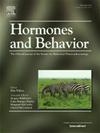Vasotocin and oxytocin modulation of the endocrine and behavioral response to an aggressive challenge in male Siamese fighting fish
IF 2.5
3区 医学
Q2 BEHAVIORAL SCIENCES
引用次数: 0
Abstract
Aggressive behavior is an adaptive trait present across all taxa. However, the neuroendocrine mechanisms regulating it, particularly in fish, are not well understood. Oxytocin (OXT) and arginine vasotocin (VT) are known modulators of aggression, but their actions remain controversial. This study tested the possible modulation of endocrine and behavioral responses to an aggression challenge by these nonapeptides in Siamese fighting fish, Betta splendens, a species known for its intrinsic aggressiveness. Male B. splendens were injected with different dosages of either Manning compound or L-368,899, VT and OXT receptor antagonists respectively, and were exposed to a mirror challenge for 30 min. While all fish displayed high levels of aggression toward their mirror image, no differences were observed between control-injected and treatment fish. However, blocking VT inhibited the post-fight increase in plasma levels of the androgen 11-ketotestosterone (KT). To further investigate this result, testis tissue from males was incubated with and without VT and Manning compound, and KT levels were measured after 180 min. Results showed a direct effect of VT on in vitro KT secretion, indicating the presence of VT receptors in the testes of this species. Overall, the study does not support a modulatory role of VT or OXT in aggressive behavior, although VT might be implicated in the regulation of peripheral androgen response to aggression in B. splendens.
雄性暹罗斗鱼的荷尔蒙和催产素对内分泌和行为反应的调节
攻击行为是所有类群都存在的一种适应性特征。然而,人们对调节这种行为的神经内分泌机制,尤其是鱼类的神经内分泌机制并不十分了解。催产素(OXT)和精氨酸血管收缩素(VT)是已知的攻击行为调节剂,但它们的作用仍存在争议。本研究测试了这些非肽类物质对暹罗斗鱼白芨(一种以内在攻击性著称的鱼类)攻击性挑战的内分泌和行为反应的可能调节作用。给雄性白芨注射不同剂量的 Manning 复合物或 L-368,899(分别为 VT 和 OXT 受体拮抗剂),并让其接受镜像挑战 30 分钟。虽然所有的鱼都对其镜像表现出高度的攻击性,但在注射对照药剂的鱼和注射治疗药剂的鱼之间没有观察到差异。然而,阻断VT抑制了战斗后血浆中雄激素11-酮睾酮(KT)水平的增加。为了进一步研究这一结果,将雄鱼的睾丸组织与 VT 和 Manning 复合物进行孵育,180 分钟后测定 KT 水平。结果显示,VT 对体外 KT 分泌有直接影响,这表明该物种的睾丸中存在 VT 受体。总体而言,该研究并不支持 VT 或 OXT 在白芨攻击行为中的调节作用,尽管 VT 可能与白芨外周雄激素对攻击行为的反应的调节有关。
本文章由计算机程序翻译,如有差异,请以英文原文为准。
求助全文
约1分钟内获得全文
求助全文
来源期刊

Hormones and Behavior
医学-行为科学
CiteScore
6.70
自引率
8.60%
发文量
139
审稿时长
91 days
期刊介绍:
Hormones and Behavior publishes original research articles, reviews and special issues concerning hormone-brain-behavior relationships, broadly defined. The journal''s scope ranges from laboratory and field studies concerning neuroendocrine as well as endocrine mechanisms controlling the development or adult expression of behavior to studies concerning the environmental control and evolutionary significance of hormone-behavior relationships. The journal welcomes studies conducted on species ranging from invertebrates to mammals, including humans.
 求助内容:
求助内容: 应助结果提醒方式:
应助结果提醒方式:


